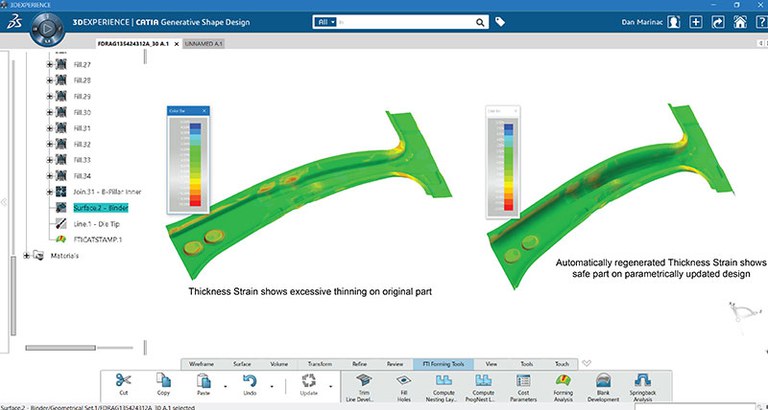CATSTAMP®

CATSTAMP® enables users to quickly and easily evaluate part and process feasibility as well as determine blank shape and spring back. It identifies formability problems (splits/wrinkles) enabling users to implement design changes earlier in the product life cycle, saving time and money. Before releasing data to tooling, engineers run CATSTAMP® to assess formability risks and optimize material usage. It considers component or tool geometry and accounts for material properties, friction, binder, addendum, blank holder force, pad pressure, draw-beads, and tailor-welded blanks.
CATSTAMP® V6 is a fully embedded application within the 3D Experience native environment and uses FTI’s proprietary Coupled Hybrid Inverse (CHI) solver for fast and accurate forming feasibility analysis. Design engineers strive to design a part free from formability issues (splits/wrinkles) and eliminate costly ECOs during the tooling design and build. CATSTAMP® enables design engineers to evaluate their designs for various manufacturing issues thereby allowing them to release sheet metal parts with greater confidence. CATSTAMP® V6 also enables engineers to implement Key Product Requirement (KPR) and Design for Manufacturability (DFM) techniques.
KPR techniques are used at automotive OEMs to review Class A surfaces while the clay models are still in Styling. The KPR analysis addresses issues such as cosmetic quality, surface distortion for mating surfaces, dent resistance, continuity of reflect lines, continuity of features, slip lines and thinning. KPRs significantly affect the product’s quality, safety, and compliance with regulations.
DFM techniques are used on Class B and C Body-In-White (BIW) components. Product designers can evaluate several forming scenarios. Engineers can predict formability (splits/wrinkles) spring back issues to reduce ECOs, develop blank size, determine material utilization, weight, with time saving outputs in Excel, PowerPoint or customized reports.
Component strains and thinning information can be uploaded to CAE Departments to increase accuracy of component performance for structural, crash, NVH, fatigue and durability analysis. Studies have shown that using this thinning and work hardening information can increase CAE accuracy up to 30%.